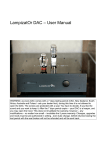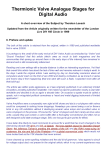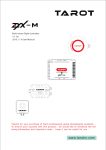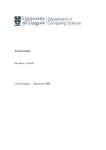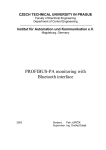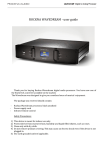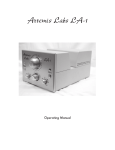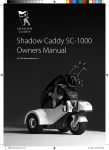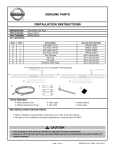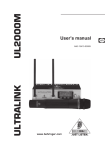Download Lampizator DAC – User Manual - GPoint
Transcript
Lampizator DAC – User Manual WARNING: as every DAC comes with a 7 days testing period (USA, New Zealand, South Africa, Australia and Poland - ask your dealer first), during this time it is not allowed to open the DAC. The screws are protected with a seal. You have to decide, if you like the sound and you want to keep it. After the 7 days period expire – your DAC is a keeper, and you may open the hood. This does not invalidate the warranty, however – any modifications – no matter how small – invalidate the 5 years warranty. Changes, upgrades and mods must be pre-authorized in writing , even tube change. DACS returned during the test period with the seal broken will not be refunded and will be sent back. Contents: Introduction.....................................................................................................................................2 Data formats....................................................................................................................................2 Audio volume level.......................................................................................................................2 AC requirements and overseas operation.........................................................................3 The heat issue.................................................................................................................................4 Optimal placement........................................................................................................................4 Power on-off cycle........................................................................................................................4 Cabling and cable handling......................................................................................................5 Tube rolling and replacement................................................................................................5 Aging problems..............................................................................................................................5 Fuse Change....................................................................................................................................6 Volume control...............................................................................................................................6 PROGRAMMING THE MODULE!..............................................................................7 COOPERATION WITH THE PREAMP........................................................................................8 DIGITAL INPUTS...........................................................................................................................10 The RESET button.......................................................................................................................12 LISTENING TO THE MUSIC.......................................................................................................13 Analog part schematics...........................................................................................................14 Power supply schematics........................................................................................................14 LampizatOr DAC Manual Introduction Thank you for choosing Lampizator DAC. We created it with huge research effort to deliver not only world class musical performance, rivaling the most expensive DACS money can buy, but also to offer very long life of the product. Simply speaking – if you adhere to some basic precautions listed below – the product should last a lifetime and hopefully in this period – will never be outperformed by a competing product. Whose lifetime one might ask – well – let’s not go into details – enough to say it should work flawlessly for the foreseeable future. The DAC should be future-proof. Shall we ever launch a major upgrade to the digital part – you can get the upgrade at very reasonable cost. Shall you decide you need some added features – you can also get them at reasonable cost anytime in the future. Be it AES/EBU input, Toslink input, BNC input, XLR outputs, volume control, information status LEDs – any option you initially forgot. We can’t be 100% sure, but it is extremely unlikely that the market and the industry in the future will embark any technology of music storage faster than 192 kHz and with more resolution that 24 bits. We already hit the human ear limits, not to mention the real needs of mass consumers (MP3). Data formats The DAC is capable of automatic recognition of all sampling rates from 44 to 192 kHz and bit rates from 16 to 24. Since few if any transports offering SPDIF format of the 192 kHz exist in the consumer market, it is hard to guarantee the operation but on the professional ones which we tried – it worked. From our experience the transmitters of SPDIF are incapable of making good square wave over 48 kHz, so if you play a 192 kHz file, be aware that on one hand you “play” more detailed data, but at the same time your signal is waaay more distorted so at the end of the day for this reason alone it may not be worth it to chase the hi-rez rabbit. Audio volume level Tube technology allowes us to set practically unlimited volume level at the output, up to 100 x higher than from a normal CD player. We have decided to adhere to one internally set standard: the test tone of 1 kHz at -20 dB produces an output of sine wave 300 mV AC under the amp load of 47K. Thats equivalent of circa 3 V pp. Shall this be inconvenient for some reason – it is adjustable in the range of 0-1800 mV by 2 LampizatOr DAC Manual just one resistor change. The test tone is available from me via email in the form of WAV or AIFF or FLAC or MP3 file. Generally - we prefer the sound of the DAC with high output levels, and most amps don’t have any problem with that. A simple potentiometer or stepped attenuator takes care of that. Only solid state chip based preamps will saturate and distort thats why we need to know in advance about such solid state chip volume system being driven by the DAC. We will keep then the volume level at the “book” level of 2 V pp. Having said that - chip volume systems and preamps with opamps belong in home theatre (cheap one) and DEFINITELY not in high end. LampizatOr DAC should not be used with opamp based preamp, no matter how good. Because the op-amp feedback loops will remove the whole joy of music as delivered by the tubed DAC. AC requirements and overseas operation The DAC has a multi-voltage power transformer. In the TOROIDS: Looking from the top – the first wire in the bunch is neutral AC input power and it is always engaged. For 115 V operation the second wire looking clockwise is the AC phase. For 230-240-220 V operation the third wire replaces the second wire. If your dac has a serial number lower than 20 – the second wire is formed by a twisted pair. For 230 V this pair is joined together. It is not necessary, but advisable that the power cable is a quality one, not simply a computer cable. It is also advisable to use some kind of AC filter – in many cases this brings nice results. Generally under-filtering is better than over-filtering. The EI type transformers have their primary windings on the top. The two external of the three pins are 230 VAC, one external and the center = 115 V primary. The DACs with volume control, the green board which powers the volume unit has two jumpers set for 230 V and in case of 115 V - these jumpers are open and one jumper is added where it is written 115V. 3 LampizatOr DAC Manual The heat issue Many people are concerned about the heat inside the player. We want you to relax about it - that this is NOT an issue. The DAC operates well below half of its maximum allowed temperature. Tubes are DESIGNED to be hot, this is their very nature. Thats why they have internal heaters and when they are not at optimal operating temperature – they sound bad. The other components are guaranteed up to 105C and we are expecting no more than 45 degrees Celsius in the air inside the DAC. Our only advice is do not heat the box additionally by placing it for example on top of a hot class A amplifier. Give it some space around to allow free air flow and adequate cooling. Do not cover it with blankets or mats. Optimal placement Apart from the heat issue as described above, the DAC has no special placement requirements. Just remember to keep the S/PDIF cable not longer than 1,5 m (5 feet) and RCA chinch cables – not longer than that either. Since tubes are microphonic, they hate vibrations. Therefore it is forbidden to place the dac on top of the speakers or a sub. Choose least vibrating location, preferably one foot behind the plane of the speakers. Power on-off cycle The tube lifetime, almost like the life of a car engine in polar climate – is determined largely by the on-off cycle. The heat expansion coefficient of the glass is so much different than that of the metal, that the air-tight seal of the metal pins can leak oxygen inside the tube and eventually kill it. Even if it is just one molecule per day. So in other words it is better to keep the DAC always on, than to switch it on and off more than necessary. The lampizator DAC (level 3 and up) has a slow start feature which brings the high voltage supply gradually up, at the rate of two- to five volts per second. The PSU reaches 300 V DC after 90 seconds. This helps to extend tube life. The DAC is also equipped with voltage down feature (bleeders) which reduce the power voltage upon switch-off at roughly the same rate. On top of that – the tubes are operated always around 25% of full nominal power, which greatly increases their life expectancy. Combining all the factors together, the tube lifetime should be anywhere between 10 and 20 years, assuming the player is switched off only once per day, for the night. 4 LampizatOr DAC Manual Cabling and cable handling Just to be sure that we know what we are doing: - AC cable can be freely plugged and unplugged during operation. It is OK for the DAC but NOT OK for the amplifier and speakers. A loud thump may appear after switch off. Please turn your volume fully down before switching off the DAC. - SPDIF cable should be plugged and unplugged when the transport is powered off. The DAC can be on. However doing it on „hot” when all is working – is not dangerous for the DAC as long as the AC power supply has the GND for all products (DAC, transport, amps). - Signal cables can be plugged / unplugged with the amplifier volume turned fully down. - Whatever you do – we strongly advice to use only chinch cables (analog and digital) with Neutrik plugs. This GREATLY reduces risks associated with the commonly found problem of HOT BEFORE COLD connection. Please use a decent AC cable. We suggest spending around 100 Euro for a good AC cable, not more but not less. Please use a decent digital interconnect. In our DAC it is completely unimportant what is the wave characteristic impedance of the cable (the famous 75 Ohms). Just use the cable that sounds good to you. Analog as well as digital interconnects can be tried. Best results are obtained with silver cables. Let your ears decide, not specs of the cable. Tube rolling and replacement W took an expensive and painful decision to sell the DAC with the best tubes we can find in consistent sustainable supply. Therefore we feel you should not be tempted to change them for any reason. If you feel that you MUST try other tubes – we need to pre-authorize it in writing. Otherwise you loose warranty, sorry. This does not concern 300B, which can be rolled freely. It is possible to order the special version of DAC for tube rolling fans. It will have specially configured multiple sockets to enable the use of almost all existing tubes from 6SN7GT to ecc83 or e182cc Aging problems As already explained above, the DAC should age very very slowly. 5 LampizatOr DAC Manual The digital PCB should last a lifetime. The transformer, the paper in oil caps, the cables, plugs, sockets – should last a lifetime. There are only 4 electrolyte caps which we selected from premium brands and they should last circa 25-30 years. Other than that we suggest to change tubes every 10 years. So - short of a thunderstrike – we expect no failures or aging problems before 20-30 years. Fuse Change The DAC is equipped with a non-repairable glass fuse circuit breaker inside the IECAC socket at the back. There is also one spare fuse provided in the little drawer. The fuses are 1A and overrated by the factor of 3. Therefore it is impossible for the fuse to blow without a specific reason - a failure inside the player. Consequently, if the fuse burns, it is a signal to send the dac for service and NOT change the fuse. Obviously the second fuse will burn as well. WE ABSOLUTELY DO NOT ALLOW changing the fuses for any larger size than 1A or installing the “audiophile silver bolts” in place of the fuse. Fuses are there mainly to SAVE YOUR LIFE. And we mean that. Volume control (This converns DACs equipped with TAIV volume control modules with display and remote). The volume control is an extremely nice module, that changes the way we use the DAC. The module consists of 5 elements: 1. Power supply with the DAC power management relay, allowing to switchON/OFF the whole DAC via the remote while keeping the volume module powered. 2. The display - amber backlit 2 x 16 alpha LCD, which is our GUI 3. The microprocessor board with memory, firmware and the chip that controls the relays 4. Relay volume board with resistor ladder. The microprocessor connects the resistors in such way that they form a resistive attenuation L-Pad with 63 steps of logarithmic attenuation. The overall impedance is held at almost constant 25k and the steps are calibrated in 1 db distances. 5. The virtual potentiometer with push action The module is capable not only of volume adjustment but also of the input selection. It means ANALOG input - like in a preamp. The module does not select digital signals. 6 LampizatOr DAC Manual Using the volume module: Press the volume knob down for 3 seconds and the display will show selection of 4 analog inputs . Turn the knob to select the desired input. Press for 3 s again to exit this menu. The input selection is available from the remote in direct mode - just press digit 1 to 4 to choose input or use left - right cursor buttons. ** in most DACS that we ship, this function of input selection is disabled because the DAC is the only active input. You can bring it back by entering the PROGRAMMING menu. PROGRAMMING THE MODULE Press the volume knob for 10 seconds continuously and the display will enter the programming mode. turn the knob clockwise to go to next menu. Press the knob for 2 s to enter the selected sub-menu. To exit the sub menu and go back to menu list - press the knob for 2 s. To exit programming mode - turn the knob right till you choose EXIT SETUP and press knob for 2 s. 1. Volume step speed: it is default set at 3 , the higher the number the slower is the reaction of volume level to turning the knob. For example, choosing 6 means that it takes 3 full turns 360 degrees to adjust the volume full scale. We like it at 6. 2. Number of inputs: choose a limitation of analog inputs to avoid having to deal with non-existing inputs. The normal DACS have a limitation set to one. 3. Backlight display - choose a percentage of DIMMING - from full light intensity of display that dims AFTER the period of inactivity. Setting 40 % means, that the display will be lit 100% during any operation with knob or remote, but when we listen - the display will dim to 40 % of the full level. We like it on 35 because we like listening in the dark room. 4. IR Learning - you can program any remote control you want to perform the desired actions. For example - if you use a CD transport remote, you can choose two buttons on it that aren’t used for CD and program them to be Vol-Up and Vol-Down, so you use just one remote. After entering this sub-menu the display will ask you to press the remote button and you acknowledge the signal code by pressing the knob for 2 s and proceeding to next function. The display will guide you. At the end choose exit. 5. OUTPUTS: the module has 3 freely programmable latching or non latching outputs activated by the remote control. They can be wired to perform a specific function inside the DAC (say reset, change frequency, activate deemphase or something like that. 6. Logo change: you can change the welcome logo to your own. 7 LampizatOr DAC Manual 7. Alphanumeric descriptors: you can add alpha descriptors to the 4 inputs. the first input by default is DAC. Add Phono, Tuner, TV to the other inputs of analog stereo signals. (The DAC must be equipped with the RCA inputs to use this function). 8. After reaching the end of menu list - the display will show EXIT SETUP. The options we programmed will be written to a non volatile memory and stored forever. There is no limit to how many times we can repeat this operation. MUTE function: this is useful to use instead of turning the volume all the way down. Available ONLY via remote. POWER OFF - the DAC will be switched off fully but the remote module will be always alive to enable you to power it ON again. *** Do not be upset about the C2011 text - it means the date the firmware was written for this module and not the year of manufacturing of the DAC. 0dB operation: at full volume - 0dB the DAC operates as if there was no volume module. This position is recommended for systems with own volume control: preamp or integrated amp. COOPERATION WITH THE PREAMP The DAC with volume control should sound audibly cleaner and more direct without any preamp between the DAC and the amp. The preamp, however good, will veil a lot of the DAC’s natural clarity, speed and directness. If you feel you need the preamp nevertheless, use DAC at the full volume or order your DAC without volume module. The load presented by the preamp or amp or simply the next analog component that the DAC sees, should be as high as possible. It is measured in kilo-Ohms and 100Kilo Ohms is a perfect ballpark value. More is VERY rarely seen. 47 K is next common value, and it is great too. 20 K is kind of on a low side, but we can handle that. Lower than 20 is bad news. We must configure the DAC with additional cathode follower buffer stage. The DAC will not be damaged in any way, but at around 10K of load the dynamics of the dac will start to fade away. Having said that - every properly designed amp or preamp keeps the load value above 40k. And if it doesn’t - we simply don’t choose such amp because it was not designed with audiophiles in mind. 8 LampizatOr DAC Manual 9 LampizatOr DAC Manual DIGITAL INPUTS There are three data types that our DAC can read internally: biphase, i2s and USB. The bi-phase can come in many forms, but the most common are: S/PDIF (sony/Philips data inter face) by means of single ended square wave of amplitude around 0,5 V pp AES/EBU - the same as S/PDIF but the signal is a mirrored (balanced) pair of square wave around 2,5 V pp (till 5 V pp) TTL - just as S/PDIF but 5 V pp TOSLINK - a fiber optic transmission of S/PDIF producing at the DAC the 5 V TTL electrical signal. RS422 - it is practically the same as AES/EBU The i2S is the same as biphase but separated into 4 signals - each carrying only one type of information. Biphase encodes 4 groups of informations in one signal stream. Specifically they are: System Clock, Bit Clock, Left/Right Clock and Data. We can install these four in any type of connector, because there is no standard. Most customers use RJ45 LAN socket or simply four RCA sockets just like in TV RGB. 10 LampizatOr DAC Manual I2S Pinouts The JKI2S uses a RJ45 connector to output I2S signals according to the following pin outs: 1 2 3 4 5 6 7 8 SLCK SLCK GND SDATA SDATA GND L/RCLK L/RCLK GND MCLK MCLK GND 11 LampizatOr DAC Manual USB data requires installation of additional converter module to convert the “packet” data into a steady SPDIF stream. Our asynchronous converter not only has internal RAM and own clock and own power supply and own transformer, but also it has three simultaneous outputs we can use: S/PDIF, AES/EBU and i2s. The USB module requires a driver for Windows to recognize it. MAC OS works without any drivers. the driver for Windows is available at www.lampizator.eu/USB.zip Do not install windows driver with the DAC USB connected to PC. USB module can be added as a paid option to existing DACs. Our USB converter is capable of working with 32 bit files with 380kHz signal frequency. Only USB2 rated cables will work. The USB standard printer cable will not work. USB cables with ferrite filters (the “thing” on the cable ) will not work. For best results please download the jPlay software to manage the Windows parameters and optimize them for working with music via USB. The RESET button. The DAC automatically recognizes the frequency and file format of incoming data and adjusts everything accordingly. But sometimes after power up cycle, the recognition is not synchronized with the chip’s clock. Thats why we installed the RESET buttons at the back of the unit. These buttons are monostable (not latching) and they have to be pressed for circa one second. If there are two buttons we can try to depress them both or one by one or only one. It does not matter. Usually, after the power up and resetting - the DAC will play as long as it keeps being powered without a need to reset it again. 12 LampizatOr DAC Manual LISTENING TO THE MUSIC some practical tips Please use good shelf for the DAC. Do not place it on speakers, subs, or even on transports or amps. Again - tubes hate vibrations. If you try the special devices for placement, we feel that: granite or marble is bad (ringing). Cones are just plain ridiculous. Ceramic ball bearing feet are great. Good wood is great if thick. Others - please try. The way stereo sound is created inside the DAC can - under optimal condition - recreate the musical experience as it sounded live. It means that two speakers can cause us listeners to hear sounds everywhere around us, above, below, far in front, almost close to our face, and also behind us. This type of imaging is our goal. The sound must be able to get detached from the speakers (so called disappearing act) and the more our DAC helps doing it - the higher we value it (and price accordingly). We voice our DACs to be as 3-D as possible. From our experience speakers should be positioned following the basic rules of LampizatOr Nirvana Room: 1. Speakers and listeners head form unilateral triangle (3 x 60 degrees) with the distance between speakers being exactly equal to distance head-speaker. 2. Head must be in exactly middle of the speaker base and the speaker base must be exactly symmetrical versus side walls. We place speakers and measure the distance from side walls with 1 cm accuracy. 3. The distance of the speakers to the side walls and speakers to rear wall should not be equal. We recommend 1,4 times smaller or 1,4 times larger distance- but not equal. We measure that counting from the magnet of the bass driver. 4. Distance from rear wall of speaker and rear wall of the room should be no less than 0,5 m or 2 feet. 5. Ideally, the tweeter should be at the height of the ear or up to 10 cm higher, but nOT LOWER. Speakers with tweeters lower than 90 cm sound terribly wrong. 6. The chair or sofa should not have the back support higher than the person’s shoulders - in other words - should not be just behind the ears 7. Feet are the second ears of our body. They receive a lot of vibration stimulation and the brain combines this with the hearing. So we advise to have a piece of floor without any carpet directly where our feet are. Listening with feet (preferably bare) on the hard floor greatly enhances our perception of music. It is advisable to have rug or carper between listener and speakers but not under the feet. 8. It is advisable to put something soft directly on the wall behind the speakers 13 LampizatOr DAC Manual 9. The so called toe-in - the degree by which the speakers face the listener and not alongside the walls straight - is very critical. The rule of thumb is to toe in half way between standing straight and aiming at the listeners ear. Or slightly more straight, but not more towards the head. BURN IN PERIOD The DAC comes straight from our factory after around 24 Hours of testing so it is not exactly “new” but it is not burned-in enough. Our customers report back, that after 3 days of constant powering (playing or not) the DAC opens up significantly. Further improvements are observed after up to 7 days when things stabilize. Additional one day burn in is needed after every time the DAC: travels somewhere (vibrations), or is disconnected for over a month or is subject to cold temperature - like in the car trunk, when left overnight. When the DAC is fully burned in, the sound quality is stable, and we only need to warm it after powering every day. The DAC starts to play after 20 seconds. The tubes reach full parameters and stabilize after 40 s. The whole system reaches operating temperature plateau after circa 20 minutes and it is ready for serious listening. ENJOY YOUR MUSIC LIKE NEVER BEFORE ! Analog part schematics Power supply schematics 14














